Abstract
Climate change is a major threat to coral reef ecosystems worldwide. A key determinant of the fate of reef corals in a warming climate is their capacity to tolerate increasing thermal stress. Here, an increase in thermal tolerance is demonstrated for three major coral genera (Acropora, Pocillopora and Porites) following the extensive mass bleaching event that occurred on the Great Barrier Reef (Australia) in 1998. During the subsequent and more severe thermal stress event in 2002, bleaching severity was 30–100% lower than predicted from the relationship between severity and thermal stress in 1998, despite higher solar irradiances during the 2002 thermal event. Coral genera most susceptible to thermal stress (Pocillopora and Acropora) showed the greatest increase in tolerance. Although bleaching was severe in 1998, whole-colony mortality was low at most study sites. Therefore, observed increases in thermal tolerance cannot be explained by selective mortality alone, suggesting a capacity for acclimatization or adaptation. Although the vulnerability of coral reefs remains largely dependent on the rate and extent of climate change, such increase in thermal tolerance may delay the onset of mass coral mortalities in time for the implementation of low-emission scenarios and effective management.



Similar content being viewed by others
References
Access Economics (2007) Measuring the economic and financial value of the Great Barrier Reef Marine Park 2005/2006. Report by Access Economics Pty Limited for Great Barrier Reef Marine Park Authority. Great Barrier Reef Marine Park Authority, Townsville
Anthony KRN, Fabricius KE (2000) Shifting roles of heterotrophy and autotrophy in coral energetics under varying turbidity. J Exp Mar Biol Ecol 252:221–253. doi:10.1016/S0022-0981(00)00237-9
Anthony KRN, Ridd PV, Orpin A, Larcombe P, Lough JM (2004) Temporal variation in light availability in coastal benthic habitats: effects of clouds, turbidity and tides. Limnol Oceanogr 49:2201–2211
Anthony KRN, Connolly SR, Hoegh-Guldberg O (2007) Bleaching, energetics, and coral mortality risk: effects of temperature, light, and sediment regime. Limnol Oceanogr 52:716–726
Anthony KRN, Hoogenboom M, Grottoli A, Middlebrook R, Maynard JA (in review) Energetics approach to predicting coral mortality risk from bleaching. Functional Ecology
Ayre DJ, Hughes TP (2004) Climate change, genotypic diversity and gene flow in reef-building corals. Ecol Lett 7:273–278. doi:10.1111/j.1461-0248.2004.00585.x
Baird AH, Marshall PA (1998) Mass bleaching of corals on the Great Barrier Reef. Coral Reefs 17:376. doi:10.1007/s003380050142
Baird AH, Marshall PA (2002) Mortality, growth and reproduction in scleractinian corals following bleaching on the Great Barrier Reef. Mar Ecol Prog Ser 237:133–141. doi:10.3354/meps237133
Baird AH, Cumbo VR, Leggat W, Rodriguez-Lanetty M (2007) Fidelity and flexibility in coral symbioses. Mar Ecol Prog Ser 347:307–309. doi:10.3354/meps07220
Baker AC (2001) Ecosystems: reef corals bleach to survive change. Nature 411:765–766. doi:10.1038/35081151
Baker AC (2003) Flexibility and specificity in coral-algal symbiosis: diversity, ecology, and biogeography of Symbiodinium. Annu Rev Ecol Evol Syst 34:661–689. doi:10.1146/annurev.ecolsys.34.011802.132417
Baker AC, Starger CJ, McClanahan T, Glynn PW (2004) Corals’ adaptive response to climate change. Nature 430:741. doi:10.1038/430741a
Berkelmans R, Oliver JK (1999) Large-scale bleaching of corals on the Great Barrier Reef. Coral Reefs 18:55–66. doi:10.1007/s003380050154
Berkelmans R, van Oppen M (2006) The role of zooxanthellae in the thermal tolerance of corals: a ‘nugget of hope’ for coral reefs in an era of climate change. Proc R Soc Lond B Biol Sci 273:2305–2312. doi:10.1098/rspb.2006.3567
Berkelmans R, De’ath G, Kininmonth S, Skirving WJ (2004) A comparison of the 1998 and 2002 coral bleaching events on the Great Barrier Reef: spatial correlation, patterns, and predictions. Coral Reefs 23:74–83. doi:10.1007/s00338-003-0353-y
Brown BE (1997) Adaptation of reef corals to physical environmental stress. Adv Mar Biol 31:221–299. doi:10.1016/S0065-2881(08)60224-2
Brown BE, Downs CA, Dunne RP, Gibb SW (2002) Exploring the basis of thermotolerance in the reef coral Goniastrea aspera. Mar Ecol Prog Ser 242:119–129. doi:10.3354/meps242119
Coles SL, Brown BE (2003) Coral bleaching-capacity for acclimatization and adaptation. Adv Mar Biol 46:183–223. doi:10.1016/S0065-2881(03)46004-5
Dunne RP, Brown BE (2001) The influence of solar radiation on bleaching of shallow water reef corals in the Andaman Sea, 1993–1998. Coral Reefs 20:201–210
Edmunds PJ (1994) Evidence that reef-wide patterns of coral bleaching may be the result of the distribution of bleaching susceptible clones. Mar Biol (Berl) 121:137–142. doi:10.1007/BF00349482
English S, Wilkinson CR, Baker V (2004) Survey manual for tropical marine resources, 2nd edn. Australian Institute of Marine Science, Townsville
Fautin DG, Buddemeier RW (2004) Adaptive bleaching: a general phenomenon. Hydrobiologia 530–31:459–467. doi:10.1007/s10750-004-2642-z
Ferrier-Pages C, Allemand D, Gattuso JP, Jaubert J, Rassoulzadegan R (1998) Microheterotrophy in the zooxanthellate coral Stylophora pistillata: Effects of light and ciliate density. Limnol Oceanogr 43:1639–1648
Fitt WK, Brown BE, Warner ME, Dunne RP (2001) Coral bleaching: interpretation of thermal tolerance limits and thermal thresholds in tropical corals. Coral Reefs 20:51–65. doi:10.1007/s003380100146
Garrett KA, Mundt CC (1999) Epidemiology in mixed host populations. Phytopathology 89:984–990. doi:10.1094/PHYTO.1999.89.11.984
Gates RD, Edmunds PJ (1999) The physiological mechanisms of acclimatization in tropical reef corals. Am Zool 39:30–43
Gleeson MW, Strong AE (1995) Applying MCSST to coral-reef bleaching. Adv Space Res 16:151–154. doi:10.1016/0273-1177(95)00396-V
Glynn PW, Mate JL, Baker AC, Calderon MO (2001) Coral bleaching and mortality in Panama and Equador during the 1997–1998 El Nino Southern Oscillation event: spatial/temporal patterns and comparisons with the 1982–1983 event. Bull Mar Sci 69:79–109
Grottoli AG, Rodrigues LJ, Juarez C (2004) Lipids and stable carbon isotopes in two species of Hawaiian corals, Porites compressa and Montipora verrucosa, following a bleaching event. Mar Biol (Berl) 145:621–631. doi:10.1007/s00227-004-1337-3
Hoegh-Guldberg O (1999) Climate change, coral bleaching and the future of the world’s coral reefs. Mar Freshw Res 50:839–866. doi:10.1071/MF99078
Hoegh-Guldberg O (2004) Coral reefs in a century of rapid environmental change. Symbiosis 37:1–31
Hoegh-Guldberg O, Mumby PJ, Hooten AJ, Steneck RS, Greenfield P, Gomez E et al (2007) Coral reefs under rapid climate change and ocean acidification. Science 318:1737–1742. doi:10.1126/science.1152509
Hughes TP, Tanner JE (2000) Recruitment failure, life histories, and long-term decline of Caribbean corals. Ecology 81:2250–2263
Hughes TP, Baird AH, Dinsdale EA, Moltschaniwskyj NA, Pratchett MS, Tanner JE et al (2000) Supply-side ecology works both ways: the link between benthic adults and larval recruits. Ecology 81:2241–2249
Hughes TP, Baird AH, Bellwood DR, Card M, Connolly SR, Folke C et al (2003) Climate change, human impacts, and the resilience of coral reefs. Science 301:929–933. doi:10.1126/science.1085046
IPCC (2007). Clim Change 2007: The Physical Basis. Contribution of Working Group I to the Fourth Assessment Report of the Intergovernmental Panel on Climate Change, IPCC Geneva. http://www.ipcc.ch/, Geneva
Jimenez C, Cortes J, Leon A, Ruiz E (2001) Coral bleaching and mortality associated with the 1997–98 El Nino in an upwelling environment in the eastern Pacific (Gulf of Papagyo, Costa Rica). Bull Mar Sci 69:151–169
Kennedy VS, Twilley RR, Kleypas JA, Cowan JH, Hare SR (2002) Coastal and marine ecosystems and global climate change: potential effects on US resources. Pew Center on Global Climate Change, Arlington
Knowlton N (2001) The future of coral reefs. Proc Natl Acad Sci USA 98:5419–5425. doi:10.1073/pnas.091092998
Lough JM (2000) 1997–98: unprecedented thermal stress to coral reefs? Geophys Res Lett 27:3901–3904. doi:10.1029/2000GL011715
Marshall PA, Baird AH (2000) Bleaching of corals on the Great Barrier Reef: differential susceptibilities among taxa. Coral Reefs 19:155–163. doi:10.1007/s003380000086
Masiri I, Nunez M, Weller E (2008) A ten-year climatology of solar radiation for the Great Barrier Reef: implications for recent mass coral bleaching events. Int J Remote Sens (in press)
Maynard JA (2004) Spatial and temporal variation in bleaching susceptibility and the ability of SST variables to describe patterns in bleaching response, 1998 and 2002 events, central GBR. Thesis. James Cook University
McClanahan TR, Baird AH, Marshall A, Toscano MA (2004) Coral bleaching and mortality responses of hard corals between southern Kenya and the Great Barrier Reef, Australia. Mar Pollut Bull 48:327–335. doi:10.1016/j.marpolbul.2003.08.024
Muscatine L (1990) The role of symbiotic algae in carbon and energy flux in reef corals. In: Dubinsky Z (ed) Ecosystems of the world: coral reefs, vol 25. Elsevier, Amsterdam, pp 75–87
Pinker RT, Laszlo I (1991) Modeling surface solar irradiance for satellite applications on a global scale. J Appl Meteorol 31:194–211. doi:10.1175/1520-0450(1992)031≤0194:MSSIFS≥2.0.CO;2
Pittock B (2003) Climate change: an Australian guide to the science and potential impacts. Australian Greenhouse Office, Canberra
Podesta GP, Glynn PW (2001) The 1997–98 El Nino event in Panama and Galapagos: an update of thermal stress indices relative to coral bleaching. Bull Mar Sci 69:43–59
Riegl B (1999) Corals in a non-reef setting in the southern Arabian Gulf (Dubai, UAE): fauna and community structure in response to recurring mass mortality. Coral Reefs 18:63–73. doi:10.1007/s003380050156
Riegl B (2002) Effects of the 1996 and 1998 positive sea-surface temperature anomalies on corals, coral diseases and fish in the Arabian Gulf (Dubai, UAE). Mar Biol (Berl) 40:29–40
Rowan R (2004) Coral bleaching—thermal adaptation in reef coral symbionts. Nature 430:742. doi:10.1038/430742a
Sheppard CC (2003) Predicted recurrences of mass coral mortality in the Indian Ocean. Nature 425:294–297. doi:10.1038/nature01987
Spencer-Davies P (1984) The role of zooxanthellae in the nutritional energy requirements of Pocillopora eydouxi. Coral Reefs 2:181–186
Wilkinson CR (ed) (2002) Status of coral reefs of the world: 2002. Australian Institute of Marine Science, Townsville
Acknowledgments
We thank P. J. Turner from CSIRO for help with SST analyses, R. Berkelmans for providing bleaching survey and in situ temperature data from the Australian Institute of Marine Science, and Manuel Nunez for data on surface irradiance, A. Baird, T. Hughes, D. Bellwood, D. Blair, C. Smith and A. Kerswell for comments on the manuscript and M. Hoogenboom for assistance with graphs. The Australian Greenhouse Office, Great Barrier Reef Marine Park Authority, and grants from the University of Melbourne and the Applied Environmental Decision Analysis CERF Hub (JAM and PAM) all supported this work, as well as grants from the Australian Research Council and ARC Centre of Excellence for Coral Reef Studies to KRNA and IM.
Author information
Authors and Affiliations
Corresponding author
Additional information
Communicated by H.O. Pörtner.
Rights and permissions
About this article
Cite this article
Maynard, J.A., Anthony, K.R.N., Marshall, P.A. et al. Major bleaching events can lead to increased thermal tolerance in corals. Mar Biol 155, 173–182 (2008). https://doi.org/10.1007/s00227-008-1015-y
Received:
Accepted:
Published:
Issue Date:
DOI: https://doi.org/10.1007/s00227-008-1015-y




